Lou’s Views
News & Views / April Edition
Calendar of Events –

Strawberry & Wine Fest
April 27th
Sunset Beach
.
The Strawberry and Wine Festival, hosted by the Old Bridge Preservation Society since 2014. There will be wines available from Silver Coast Winery with strawberries as the main fare of the day. It’s a day of wine, food, entertainment, and craft vendors.
For more information » click here

Days at the Docks Festival
April 26th & 27th
Holden Beach
The annual festival which started in the 1980’s occurs in April or May and is sponsored by the Greater Holden Beach Merchants Association. It’s the Holden Beach way to kick-off the Spring and start the vacation season. In addition to the food and arts & crafts, enjoy live music & entertainment, a horseshoe tournament and the world famous “Bopple Race”. Lots of activities for the entire family!
For more information » click here

Blue Crab Festival
May 17th & 18th
Little River SC
.
Little River has been celebrating the World Famous Blue Crab Festival since 1981. It is held on the waterfront in Little River and is one of the largest festivals in the Southeast. The purpose of this festival is one that supports and showcases the fabulous atmosphere of the local communities.
For more information » click here

Conway Riverfest Celebration
June 28th
Conway SC
Held along the Waccamaw River in downtown Conway the festival celebrates Independence Day since 1980 with music and events for the entire family.
For more information » click here

N.C. 4th of July Festival
July 4th
Southport
The patriotic spirit of America is alive and well in the City of Southport. For over 200 years this small maritime community has celebrated our nation’s independence in a big way. Incorporated as the N.C. 4th of July Festival in 1972 the festival committee strives to keep the focus of the festival on honoring our nation’s birthday with a little fun thrown in.
For more information » click here

Battleship Blast 4th of July Celebration
July 4th
Wilmington
.
.
Annual 4th of July Celebration at Riverfront Park in downtown Wilmington since 1981. Featured entertainment will perform from 6:00 PM to 9:00 PM, followed by fireworks at 9:05 PM launched from a barge in the Cape Fear River adjacent to the USS North Carolina Battleship. The only place you need to be this holiday is downtown Wilmington for the best view of fireworks.
For more information » click here
Brunswick County invites residents to participate in lifesaving certification training
Brunswick County’s Risk Management and Parks and Recreation departments are partnering to offer First Aid/CPR/AED Certification Training in 2025. This new training program is designed to provide residents with the knowledge and skills needed to recognize and respond appropriately to cardiac, breathing, and first aid emergencies.
“Many accidents at work and at home—such as bruises and cuts sustained from tripping or burns given by heating equipment—can be helped by a bystander with the proper resources and training,” Risk Manager Andy Yoos said. “That’s why it’s important for everyone to know how to perform basic lifesaving care.”
The training is open to any Brunswick County resident 12 years of age and older. Participants under 18 years of age must be accompanied by an adult guardian for the entire training session. Upon successful completion of the course, participants will receive an American Trauma Event Management (ATEM) First Aid/CPR/AED certification card, which is valid for 2 years.
The 2025 training sessions will be held on Feb. 15 inside the Town Creek Park Community Building, April 26 inside the Leland Field House, June 7 inside the Lockwood Folly Community Building, Aug. 9 inside the Waccamaw Park Community Building, and Oct. 4 inside the Leland Field House. Participants must register and pay online before the training date.
There are only 12 seats available per training session and the registration fee is $10 per person. Each class will consist of an AM Session from 9 a.m. to 12 p.m., a 30-minute lunch break*, and a PM session from 12:30 p.m. to 3:30 p.m. You must attend and complete both sessions to receive certification.
*Participants must bring their own lunch and beverages.
Upcoming Training Session
Saturday, June 7, 2025 / Supply Area
Location: Lockwood Folly Community Building, 1691 Stanbury Rd SW, Supply, NC 28462
Time: 9 a.m. to 3:30 p.m.
Cost: $10 per person
Learn more and register online on the Brunswick County Parks and Recreation RecDesk website.
For questions or more information about the training program, email Brunswick County Risk Management.
For more information » click here
 Discover a wide range of things to do in the Brunswick Islands for an experience that goes beyond the beach.
Discover a wide range of things to do in the Brunswick Islands for an experience that goes beyond the beach.
For more information » click here.
Calendar of Events Island –
THB Newsletter (02/26/25)
Yoga Location Change
The Town of Holden Beach offers beginner friendly yoga classes on Mondays, Wednesdays and Fridays at 10:00 a.m. The class is taught by Alice Ledford. Fee is $6 for residents and $8 for non-residents. Classes will be held at the multipurpose court at Bridgeview Park.
 Concerts on the Coast Series
Concerts on the Coast Series
The Town’s summer concert series calendar has been released! Live performances featuring local musical groups will be held at the Bridgeview Park picnic pavilion across from Town Hall. It will be on Sunday evenings at 6:30pm from May 25th to August 31st. The concerts are free of charge.
Summer Concert Schedule * Lou’s Views
Parks & Recreation / Programs & Events
For more information » click here
Reminders –
 Free Cleanup Week
Free Cleanup Week
The next Free Cleanup Week at the Brunswick County Landfill will take place April 21 through 26, 2025. Brunswick County property owners and residents can dispose of all materials, except for regular household trash and hazardous waste, free of charge during Free Cleanup Week. Individuals can dispose of metal, tires, electronics, latex paint, clothing, shoes, used oil, oil filters, antifreeze, gasoline, fluorescent bulbs, used cooking oil, smoke detectors, household batteries, rugs, mattresses, furniture, and yard debris in their designated area at the Landfill during this week. Participants must show proof of Brunswick County property ownership or residency. Brunswick County accepts various items at the Brunswick County Landfill year-round at no charge to Brunswick County property owners and residents. See a full list of accepted items on the Accepted Items and Tipping Fees webpage. For questions, contact Brunswick County Operation Services at 910.253.2520 or email OperationServices@brunswickcountync.gov.
Location:
Brunswick County Landfill
172 Landfill Rd NE
Bolivia, NC 28422
Hours of Operation:
Monday through Friday 7:30 a.m. until 5:00 p.m.
Saturday 7:30 a.m. until 3:00 p.m.
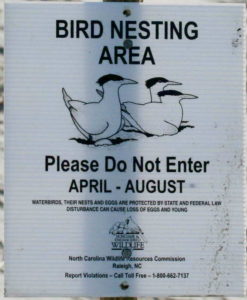
Bird Nesting Area
NC Wildlife Commission has posted signs that say – Bird Nesting Area
The signs are posted on the west end beach strand around 1335 OBW.
People and dogs are supposed to stay out of the area from April through November
. 1) It’s a Plover nesting area
. 2) Allows migrating birds a place to land and rest without being disturbed

A Second Helping
.
Program to collect food Saturday mornings (8:00am to 10:30am) during the summer at the Beach Mart on the Causeway.
1) Twenty-first year of the program
2) Food collections have now exceeded 307,000 pounds
3) Collections will begin on Memorial Day weekend
4) Food is distributed to the needy in Brunswick County
For more information » click here
.
Hunger exists everywhere in this country; join them in the fight to help end hunger in Brunswick County. Cash donations are gratefully accepted. One hundred percent (100%) of these cash donations are used to buy more food. You can be assured that the money will be very well spent.
Mail Donations to:
A Second Helping
% Sharon United Methodist Church
2030 Holden Beach Road
Supply, NC 28462
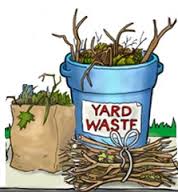 Yard Waste Service
Yard Waste Service
Yard debris pick-up will be provided twice a month on the second and fourth Fridays during the months of March, April, and May. Please have yard waste placed at the street for pick-up on Thursday night. No pick-ups will be made on vacant lots or construction sites.
Debris must be placed in a biodegradable bag or bundled in a length not to exceed five (5) feet and fifty (50) pounds. Each residence is allowed a total of ten (10) items, which can include a combination of bundles of brush and limbs meeting the required length and weight and/ or biodegradable bags with grass clippings, leaves, etc.
 News from Town of Holden Beach
News from Town of Holden Beach
The town sends out emails of events, news, agendas, notifications, and emergency information. If you would like to be added to their mailing list, please go to their web site to complete your subscription to the Holden Beach E-Newsletter.
For more information » click here
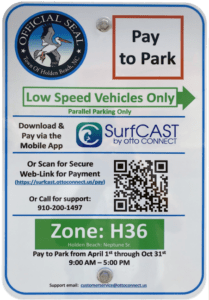 Paid Parking
Paid Parking
Paid parking in Holden Beach
Paid parking will be enforced from 9:00 a.m. to 5:00 p.m. daily with free parking before and after that time. All parking will use license plates for verification.
Rates
Parking rates for a single vehicle in all designated areas will be:
$5 per hour for up to four hours
$20 per day for any duration greater than four hours
$80 per week for seven consecutive days
Handicap Parking
A vehicle displaying a handicap license plate and/or hang tag parked in a designated handicap space is free. Any other parking space will require a parking permit via the app.
Annual Passes
Annual permits for the calendar year allow vehicles (this includes low-speed vehicles and trailers) access to designated parking.
$175 for a single vehicle
Passes can be purchased via the app, website or by telephone.
Where to Park
Per ordinance, there is no parking on the streets or rights-of-way except in designated parking spaces identified by Pay-to-Park signs. Click here to view an interactive map. The table with authorized parking can be viewed below.
Citations will be issued for:
• Parking without an active paid permit in a designated parking area
• Parking within 40 feet of a street intersection
• Parking in a crosswalk, sidewalk, or pedestrian access ways
• Parking blocking a driveway or mailbox
• Parking facing opposing traffic
• Parking in a no parking zone, or within right-of-way
• Parking on any portion of the roadway or travel lane
• Parking a non-LSV vehicle in an authorized LSV location
How Do I Pay to Park
The Town uses the SurfCAST by Otto Connect Mobile Solution. This is a mobile app downloadable for Apple and Android devices. Download the app today. Users will setup their account, enter their license plate details and pay for parking directly on the app. Alternatively, users can scan the QR Code located on the parking signs to access a secure website.
The Otto Connect customer service team will be available to help via phone and email.
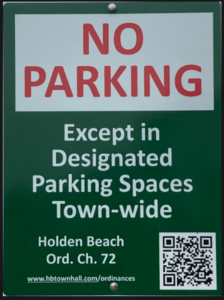

Solid Waste Pick-Up Schedule
GFL Environmental change in service, October through May trash pickup will be once a week. Trash collection is on Tuesdays only.
Please note:
. • Trash carts must be at the street by 6:00 a.m. on the pickup day
. • BAG the trash before putting it in the cart
. • Carts will be rolled back to the front of the house
GFL Refuse Collection Policy
GFL has recently notified all Brunswick County residents that they will no longer accept extra bags of refuse outside of the collection cart. This is not a new policy but is stricter enforcement of an existing policy. While in the past GFL drivers would at times make exceptions and take additional bags of refuse, the tremendous growth in housing within Brunswick County makes this practice cost prohibitive and causes drivers to fall behind schedule.
Solid Waste Pickup
An additional trash pickup is scheduled for the Saturday after Easter, April 26th.
Solid Waste Pickup Schedule –
starting the Saturday before Memorial Day (May 25th) twice a week
Recycling –
starting after Memorial Day (June 4th) weekly pick-up
Curbside Recycling – 2025
GFL Environmental is now offering curbside recycling for Town properties that desire to participate in the service. The service cost per cart is $119.35 annually paid in advance to the Town of Holden Beach. The service consists of a ninety-six (96) gallon cart that is emptied every other week during the months of October – May and weekly during the months of June – September.
Curbside Recycling Application » click here
Curbside Recycling Calendar » click here

Trash Can Requirements – Rental Properties
GFL Environmental – trash can requirements
Ordinance 07-13, Section 50.08
Rental properties have specific number of trash cans based on number of bedrooms.
* One extra trash can per every 2 bedrooms
..
§ 50.08 RENTAL HOMES.
(A) Rental homes, as defined in Chapter 157, that are rented as part of the summer rental season, are subject to high numbers of guests, resulting in abnormally large volumes of trash. This type of occupancy use presents a significantly higher impact than homes not used for summer rentals. In interest of public health and sanitation and environmental concerns, all rental home shall have a minimum of one trash can per two bedrooms. Homes with an odd number of bedrooms shall round up (for examples one to two bedrooms – one trash can; three to four bedrooms – two trash cans; five – six bedrooms – three trash cans, and the like).
Building Numbers
Ocean front homes are required to have house numbers visible from the beach strand.
Please call Planning and Inspections Department at 910.842.6080 with any questions.
§157.087 BUILDING NUMBERS.
(A) The correct street number shall be clearly visible from the street on all buildings. Numbers shall be block letters, not script, and of a color clearly in contrast with that of the building and shall be a minimum of six inches in height.
(B) Beach front buildings will also have clearly visible house numbers from the strand side meeting the above criteria on size, contrast, etc. Placement shall be on vertical column supporting deck(s) or deck roof on the primary structure. For buildings with a setback of over 300 feet from the first dune line, a vertical post shall be erected aside the walkway with house numbers affixed. In all cases the numbers must be clearly visible from the strand. Other placements may be acceptable with approval of the Building Inspector.
Upon Further Review –
 Why don’t Wilmington-area bars and restaurants offer happy hours?
Why don’t Wilmington-area bars and restaurants offer happy hours?
With so many newcomers moving to North Carolina, they often ask about happy hours specials — “Where can I get two-for-one drink specials?” or “Where’s the best spot for bottomless mimosas?” North Carolina is one of the few states that don’t allow happy hours, or alcoholic beverages available for discounted prices for a certain period of time.
What are the happy hour rules?
The regulations from the Alcoholic Beverage Control Commission say businesses may only offer happy hour food specials. That is why diners may see restaurants promote discounted appetizers for “happy hour.” If drink specials are on the menu, they must be available for at least one full business day. These rules also prohibit things like “ladies night” promotions and say businesses can’t advertise their specials in certain ways, such as on freestanding marquees or through “cents-off” style coupons.
Can a bartender sell more than one drink to a customer at a time?
While many states allow for two-for-one drinks, that is not the case here. Pitchers (of beer or margaritas, for example), carafes of wine and buckets of beer can only be sold to groups of two or more. The exceptions are that a person can purchase a round of drinks for multiple people. Drinks like a boilermaker, which includes shot and a beer, or “doubles” are considered one drink and may be sold to a single patron.
Are there other exceptions?
The ABC Commission has decided that permitted businesses can offer package deals certain times of the year. Alcoholic beverages can be included if these deals include a meal or entertainment for a single total price that reflects the actual price of the beverage. These are allowed for New Year’s, Valentine’s Day, Mother’s Day, or Father’s Day.
Read more » click here
Previously reported – February 2023
Drink it up: Bipartisan bill would legalize happy hour in North Carolina
Bars and restaurants want to reform North Carolina’s alcohol laws, some of which date back to Prohibition. But any changes will face stiff opposition from religious groups, who are influential at the Republican-controlled state legislature. It’s 5 o’clock somewhere, but in North Carolina that doesn’t mean much for after-work drink specials. Happy hours remain illegal — at least for now. On Monday, a bipartisan group of state lawmakers filed a bill that would allow individual cities and counties to legalize limited-time drink specials and promotions. “The restaurant and bar owners certainly want it,” said Republican Rep. Jason Saine, the bill’s lead sponsor. “With North Carolina growing like we have … you end up with people from many different places who are just used to having happy hour. It’s just part of the culture.” A similar bill was filed last year but didn’t pass. For the Republican-controlled legislature, any bills that loosen restrictions on alcohol sales can be tricky to navigate politically. The GOP’s supporters in the business community tend to want such rules, but many religious activists oppose them. Those who support the state’s current, relatively strict alcohol rules say they help public safety by discouraging drinking. But supporters of looser restrictions say they’re just trying to bring the state’s alcohol laws out of the Prohibition era, and into the 21st Century. “We’ve gone in the last two decades from what I’d call the ‘Hell No’ caucus, where they wouldn’t go for anything, to now, we can actually have conversations about it,” Saine said. In the past few years, some changes to booze rules have happened at the state and local levels. Liquor stores are still state-run, to the dismay of free-market advocates in both parties. But other small changes have passed, like a new law several years ago that allowed alcohol sales before noon on Sundays at grocery stores and for restaurants’ Sunday brunches. The “brunch bill,” as it was called at the time, passed to the surprise of many. Key to winning support in the GOP was that it used the same formulation Saine’s new happy hour bill also uses: It wouldn’t force the changes statewide and instead allowed individual cities and counties to vote on making the change for themselves. That allows conservative rural areas to keep stricter alcohol rules if local leaders want, while allowing bigger cities to pass the new rules.
Read more » click here
What to know about the new ‘Happy Hour Bill’ in the N.C. legislature
If there’s a question that identifies food-and-drink loving residents as newbies, it usually has something to do with North Carolina liquor laws. “Who has the best happy hour specials?” and “Where can we find bottomless mimosas this Sunday?” may seem like innocuous questions in one of the dozens of states that don’t have ABC boards. But as one of the 17 states that still do, such conversations in this state typically result in a complicated conversation about a tangle of restrictions governing the sale of spirits and cocktails. In recent years, though, there’s been a push to modernize the laws around alcohol sales. Now, North Carolinians can enjoy mimosas and Bloody Mary’s as early as 10 a.m. on Sundays and as of just last year bar patrons no longer have to have a membership to drink at their favorite watering hole. But more could be on the way. The ABC Laws/Local Sales Option bill, also known as House Bill 94, was introduced this month. It’s aimed at relaxing happy hour restrictions at local bars and restaurants. (In general, laws have been in effect for decades that prohibit bars and restaurants from offering drink specials for less than a full day.)
Here’s a look at what could change:
What the bill would do?
- Restaurants and bars could get a “Happy Hour Permit” for $100 a year.
- That would allow them to sell alcoholic beverages at special prices.
- Sell more than one alcoholic beverage to a patron for a single price, as in BOGO specials.
- Allow for “cents off” coupons.
- Offer meal-and-drink specials for a single price.
- Because advertising has also been restricted under the current law, the bill would allow business owners to promote drink specials on premises and in the media.
What happens next?
- The bill, which was introduced with bipartisan support with more than 20 sponsors, is currently in committee, said Logan Martin of Skyline Strategies, a lobbyist working with the N.C. Bar Owners Association.
- If all goes well, it could be voted on in a month. And, if it passes, it could go into effect on July 1.
- This bill is one of a handful of those addressing alcohol sales. Another, for example, concerns ready-to-drink cocktails, which are now taxed as spirits. There’s a move to lower the cost to consumers by taxing them on a wine-based system.
- If these laws pass the house, there’s also an effort to create an omnibus alcohol sales bill in the N.C. Senate that would combine them.
Read more » click here
Corrections & Amplifications –
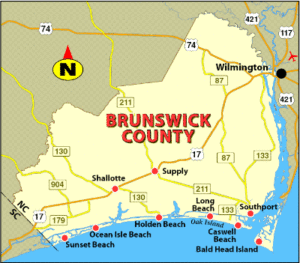 Brunswick County has grown nearly 50% since 2015, state data show
Brunswick County has grown nearly 50% since 2015, state data show
The North Carolina Budget and Tax Center has released its 2025 Economic Snapshot for Brunswick County, which is now estimated to have a population of 175,000 residents — a 48% increase over the past decade. The state Budget and Tax Center (BTC) Economic Snapshots are released annually and “provide key economic and social indicators from publicly available sources for all 100 counties in North Carolina, along with a comparison to state-level data, with measures for employment, poverty and income, affordable housing, health, education and more.” Much of the data used in the Snapshots come from the U.S. Census Bureau’s American Community Survey (ACS) and the data in the 2025 Economic Snapshot for Brunswick County covers 2019 through 2023. The snapshot indicates Brunswick County’s population has ballooned by nearly 50% since 2015. For comparison, North Carolina’s population has increased by 11% over that timeframe. Based on BTC data, the county has gained over 15,000 residents since the most recent U.S. Census estimate in 2023. Carolina Demography found that Brunswick County has seen the largest population increase in North Carolina from July 1, 2022, to July 1, 2023, growing by 4.6% over that time with a net migration, which is total move-ins subtracted by total move-outs, of 7,821. However, Brunswick County’s natural increase — the number of births subtracted by the number of deaths — from 2022 was -794. Nearby Pender County was the second fastest growing county over that timespan at 4.3%, but its net migration, 2,885, is significantly lower, according to Carolina Demography. Only Mecklenburg and Wake counties had a higher net migration than Brunswick County from 2022 to 2023, though the% change was smaller, at 1.7% for both counties. Of the 175,000 Brunswick County residents, 55,300 residents are employed and 2,400 are unemployed but actively seeking employment, creating an unemployment rate of 4.2%, the snapshot notes. The county’s working population is roughly 57,700 — just 32% of the overall population. The snapshot found fair market rent in Brunswick County in 2025 is $1,280 for a two-bedroom home, slightly more than the U.S. Census’ median gross rent of $1,267 from 2019 to 2023. The Living Income Standard — a measure of what a family consisting of one adult and two children needs in order to cover basic expenses — for Brunswick County is $78,400, compared to $87,700 for the state, the BTC found. From 2019 to 2023, the median Brunswick County worker’s yearly income was $43,800 and the median household income was $74,000. The median worker income in Brunswick County is lower than in neighboring New Hanover ($48,500) and Pender ($46,800) counties but is higher than in western neighbor Columbus County ($38,100). The median household income in Brunswick County ($74,000), however, is higher than in New Hanover County ($72,900) and Columbus County ($48,200) but lower than in Pender County ($76,800). 51% of Brunswick County renters cannot afford rent, according to the snapshot, as that percentage pay more than 30% of their incomes in rent, while 27% of renters pay more than 50% of their incomes in rent. The percentage of Brunswick County renters who pay more than 30% of their income in rent increased 2% from 49% from 2018 to 2022, but the percentage who pay more than 50% decreased slightly from 28% from 2018 to 2022. 9% of Brunswick County residents live in poverty, snapshot data show, and 13% of children live in poverty — down 1% from its rate of 14% from 2018 to 2022. Brunswick County’s high school graduation rate in 2024 was slightly lower than the overall state rate, with the county’s sitting at 85% and the state’s at 87%. Black county residents have the highest graduation rate at 90% followed by Latine residents at 87% then white residents at 85%. The NC Budget and Tax Center Economic Snapshots, including for Brunswick County, can be found here:
https://ncbudget.org/2025-economic-county-snapshots-for-north-carolina/.
Read more » click here
Odds & Ends –
 Aggressive behavior, crossbreeding are helping invasive fire ants march across NC
Aggressive behavior, crossbreeding are helping invasive fire ants march across NC
Researchers thought colder temperatures, higher elevations could stop the march of invasive fire ants across the state and northward toward the Mason-Dixon Line. Mother Nature had other ideas.
What’s worse than a small, seemingly unstoppable invader that has already caused headaches across North Carolina for decades? How about a hybrid version of the little insect with a painful sting. Since first reaching North Carolina soil in Brunswick County in 1957, the fire ants’ colonization of the Tar Heel State has been all but unstoppable. Accidental human transportation, a lack of predators, and warming temperatures thanks to climate change − potentially bringing upper elevations in the Appalachians and colder Mid-Atlantic state areas into colonization danger − have helped the insect native to South America spread quickly across North Carolina and the Southeast since the bug first hitched a boat ride to Alabama In 1918. And now, the two species of invasive fire ants found in the United States are crossbreeding, creating an even nastier and hardier bug. According to the latest “quarantine” map produced by the N.C. Department of Agriculture and Consumer Services, which requires plant materials like soil and pine straw to be inspected before being transported to ant-free locations, only 23 of the state’s 100 counties remain fire ant-free. “Right now, it just seems they are very adaptable, and that includes moving their nests further underground in the higher elevations where the temperatures are more constant year-round, to some degree outsmarting the environment,” said Amy Michael, entomological programs manager with N.C. Agriculture. Fire ants also are famous for forming into large balls of living matter during flooding events, allowing them to literally float down to new locations. After Tropical Storm Helene dropped record-levels of rain across much of Western N.C. last fall, that ability has officials especially worried about how the natural disaster might have helped the invasive species spread to new areas, said Joy Goforth, plant pest administrator with the state agriculture department. As they’ve marched across the Tar Heel State, fire ants have displaced native ant species and caused misery for farmers and suburban homeowners − not to mention some painful encounters anyone who has tangled with a fire ant mound isn’t likely to quickly forget. Their venom, similar to a bee’s or wasp’s, results in a painful, itchy pustule or blister on the skin. Only a very small portion of the population are hypersensitive to ant venom and will experience lethal allergic reactions, according to the Texas Imported Fire Ant Research and Management Project at Texas A&M. Even healthy individuals, however, may experience severe reactions such as anaphylactic shock if they suffer from a multiple stinging incident. Treatments for stings are limited, with Texas A&M recommending stings be treated as you would stings of other insects and keep them clean and intact to avoid secondary infections. Considering that a mature colony can include up to 400,000 worker ants, a queen can lay up to 1,000 eggs a day, and that there can be several colonies per acre of land, fire ants can sometimes seem like the perfect pest. “While eradicating them would be the goal in a perfect world, we really are at the point now where we are trying to manage their impacts and their spread,” Michael said.
Do we now have Franken-ants?
Mother Nature has also thrown a new wrinkle into the mix − a new “super” ant that’s a merger of the two invasive fire ant species that have reached U.S. shores. Dr. Scotty Yang, assistant professor in the Virginia Tech Department of Entomology, said hybridized fire ants are the result of interbreeding between red and black fire ants. The outcome is a fire ant that has the strength and ornery disposition of the fiercer red fire ant with the better tolerance of colder temperatures found in black fire ants. Yang said the hybrid ants have become the explorers and front guard for the fire ant invasion into colder and more northerly areas, becoming the dominant fire ant species in the upper elevations of Tennessee, Georgia, North Carolina and Virginia. And they are proving to be very successful, with a dozen Virginia counties added to that’s state fire ant quarantine map just last year. Yang said viruses that impact “normal” fire ants also have less of an impact on the hybrids, making them less likely to forage and thus less likely to carry poisoned bait back to their mounds. “In some respect, the viruses help them survive,” he said. Researchers are still trying to determine why the ants decided to crossbreed. “But once you introduce a species to a new place, anything can really happen,” Yang said.
Living with fire ants
After more than 60 years in North Carolina, officials stress that it’s no longer a question of eradicating the invaders but managing them as best we can. Still, as dire as the situation sounds, officials say residents and farmers have options. Michael said several fire ant control measures are available at garden and home improvement shops, with the best strategy one that targets different stages of the ants’ and colony’s development − especially treatments that allow bait to be brought back into the mound. Treating mounds when they appear quickly, especially those near concrete and brick walls where heat radiating from those materials allows the ants to stay active longer, also is important for good control. Officials stressed that local cooperative extension offices also are great sources of information and advice for homeowners and farmers on the best ways to control the biting invaders, and the state agriculture office also aggressively works with the plant and construction industry to help stop any accidental transportation of the ants to new locations. “Yes, they are very adaptable, and yes, they can spread pretty quickly,” Michael said. “But there are tools out there that are available to residents and businesses to help try and mitigate the impacts and their spread.”
Read more » click here
What you need to know about the 3 types of fire ants invading North Carolina
Read more » click here

Alerts
Brunswick County uses ReadyBrunswick as part of the County’s effort to continuously improve communications during emergency situations within our area. Powered by Everbridge, the ReadyBrunswick notification system sends emergency notifications in a variety of communication methods such as:
- Landline (Voice)
- VoIP (Voice over Internet Protocol)
- Mobile (Voice)
- Mobile SMS (Text Messaging)
In the case of an emergency, you may choose to receive notifications via one or all of these communication methods. It’s recommended that you register several media options to receive messages in the event a particular communication device is unavailable.
For more information » click here
Brunswick County Emergency Communications Notification System
Get notified about emergencies and other important community news by signing up for our ReadyBrunswick Emergency Notification System. This system enables us to provide you with critical information quickly in a variety of situations, such as severe weather, unexpected road closures, missing persons, evacuations of buildings or neighborhoods, and more. You will receive time-sensitive messages wherever you specify, such as your home, mobile or business phones, email address, text messages and more. You pick where, you pick how.
SIGN UP HERE to choose the type of alerts you want to receive
Save the Date:
ReadyBrunswick Preparedness Expo is Wednesday, May 7
Are you prepared for emergencies? Come by the ReadyBrunswick Preparedness Expo on Wednesday, May 7, 2025, anytime between 11 a.m. to 2 p.m. to meet with our team members and other local organizations to learn more about disaster preparedness and recovery in Brunswick County.
This family-friendly event is free to attend and will feature over 20 local organizations that are ready to help prepare you for local hazards and threats, guide you and your family in developing an emergency plan, and teach you about organizations that can assist with recovery needs.
There will be free Sunset Slush Classic Italian Ice, popcorn, a vast display of rescue vehicles, a free raffle contest, and many handouts related to emergency preparedness and recovery.
For any questions, contact our Emergency Management team at 910.253.2589 or via email.
Find preparedness information on our website anytime at brunswickcountync.gov/emergency. Learn more about the ReadyBrunswick Emergency Notification System and sign up at brunswickcountync.gov/e-alerts.
ReadyBrunswick Preparedness Expo Details
When: Wednesday, May 7, 2025, from 11 a.m. to 2 p.m. (come and go anytime)
Where: Brunswick County Government Center, 30 Government Center Drive NE, Bolivia, NC 28422 (Parking available in front of the David R. Sandifer Administration Building)
What to Expect: All Brunswick County community members and visitors are welcome to come and meet local organizations that can guide you through emergency preparedness and recovery activities.
For more information » click here
This and That –
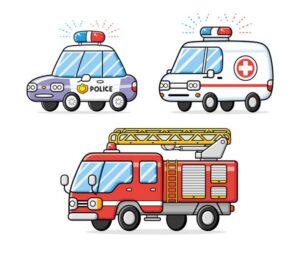 What should you do when emergency vehicles approach?
What should you do when emergency vehicles approach?
Have you ever heard the sirens of an ambulance or firetruck behind you while driving and felt unsure of what to do? Knowing how to respond in these moments can help save lives. Properly yielding allows first responders to reach their destination quickly and safely. Here’s what you need to know next time you find yourself in this situation, according to the North Carolina Department of Public Safety.
How should you respond when an emergency vehicle is approaching?
If an emergency vehicle approaches from behind
On a two-lane road, when an emergency vehicle is approaching from behind, pull over to the edge of the road and come to a complete stop. Keep your foot on the brake to let the emergency vehicle know that your vehicle is stationary. Once the emergency vehicle has passed, you may safely return to the road.
Always maintain a distance of at least 500 feet behind emergency vehicles and never follow them to navigate through traffic or bypass red lights.
If you’re stopped at an intersection and an emergency vehicle approaches from behind, remain where you are unless you are able to pull to the right. Similarly, on a four-lane highway without barriers, both sides of traffic should pull to the right when an emergency vehicle is approaching.
If an emergency vehicle approaches from the opposite direction
The N.C. Department of Public Safety advises drivers to pay attention to the situation around them when an emergency vehicle is approaching from the opposite direction. Caution and yield should be used as needed.
What about emergency vehicles stopped on the side of the road?
North Carolina has had a Mover Over Law since 2002, requiring motorists, if they can safely do so, to move one lane away from emergency vehicles with flashing lights stopped on the side of the road. Otherwise, motorists are expected to slow down and proceed with caution.
Violation of the law can result in a $250 fine, according to the N.C. Department of Public Safety.
What do the color of emergency lights mean?
The N.C. Department of Public Safety defines the following emergency light colors and their uses:
- Red lights: the fire department or an ambulance is responding to a call.
- Blue lights: police.
- Amber or yellow lights: a vehicle engaged in roadside service, including tow trucks, utility vehicles and snowplows.
- Green lights: an ambulance volunteer member is responding to a call.
Read more » click here
State’s fix for costly litter problem ‘not efficient or sufficient’
The cleanup of more than 7,000 tons of litter in North Carolina cost state agencies, local governments and nonprofits more than $56 million in 2023, according to a new report. Those figures highlighted in “The Cost of Litter in North Carolina,” a 14-page report created through a collaboration of nonprofits and the Duke University Environmental Law and Policy Clinic, are just the tip of the trash pile. “That’s a severe undercount,” said Rob Clark, Cape Fear River Watch Water Quality Programs manager and a coauthor of the report. “The issue is much, much worse than this report was able to convey.” The figures included in the report were pulled together from information obtained through public records requests, informal requests, and budgets from the North Carolina Department of Transportation and 44 nonprofits. Of nearly 40 of the municipalities requested to provide information, 19 responded. There are more than 500 municipalities in the state. Even on the low, low end, the pounds of litter and costs associated with removing it from roadsides, ditches, and creek and river banks to name a few, conveys a narrative that North Carolina has a costly, statewide litter problem. But the economic impacts of litter are only part of the story, one the report’s authors hope to place into the hands of state legislators. That’s because the basic approach to addressing litter in the state — spending money to clean it up — is not efficient, Clark said. “It doesn’t address the issue properly,” he said. “It addresses the byproduct of the litter issue, but not the sources. It’s like you’re Band-Aiding over an artery. It’s not efficient or sufficient.” That’s why the report, which was also compiled by North Carolina Conservation Network, Haw River Assembly, and MountainTrue, includes recommendations aimed at reducing litter at the source, keeping it out of the environment, and saving tax dollars. One of the report’s main recommendations, Clark said, is that the North Carolina General Assembly reinstate the ability of local governments to regulate auxiliary containers, specifically single-use plastics such as grocery bags, cups, bottles and other types of food packaging. In a last-minute move, legislators injected into the 2023 state budget language that prohibits counties and cities from adopting rules, regulations, ordinances, or resolutions that restrict, tax, or charge fees on auxiliary containers. The provision stopped locally elected officials in Asheville from moving ahead on a vote to ban single-use plastic bags and Styrofoam food containers. “We were really close for that to come up to a vote here locally and then the General Assembly put that provision into the state budget,” said coauthor Anna Alsobrook, French Broad Riverkeeper and MountainTrue’s French Broad watershed science and policy manager. The law also squashed local elected officials in Durham from deciding whether to require retailers tack on a 10-cent fee for each plastic bag given out to customers in restaurants, grocery stores and shops. “It’s really unfortunate that the state legislature took away the right of local governments to regulate pollution in their own jurisdictions,” Alsobrook said. “We’re hoping to change that.” North Carolina Sen. Julie Mayfield, D-Buncombe, and Durham Democrats Sen. Natalie Murdock and Sen. Sophia Chitlik, last month introduced a bill that would repeal limitations on auxiliary containers. The same year legislators banned a ban on single-use plastics. A survey conducted by Mason-Dixon Polling & Strategy showed that more than 80% of some 650-700 North Carolinians polled across the state supported regulations on single-use plastics, Alsobrook said. The report found that the amount of single-use plastic litter – everything from cigarette butts, Styrofoam, bottles, bags, and food wrappers – picked up throughout the state has steadily climbed since the late 1960s. In the ravages left in western North Carolina from Hurricane Helene, there is one rather ominous, tell-tale sign illustrating the abundance of single-use plastics in the environment. “There’s a ton of devastation all over the place, but there’s tons and tons of plastic films and bags hanging from trees in any given direction,” Alsobrook said. “I think that was one of the most stark things we saw for a really long time. It’s very apocalyptic looking.” And there is ongoing research about the potential human health effects of microplastics, which are considered ubiquitous in the environment because they have been found in every ecosystem on the planet. Other recommendations in the report include the statewide implementation of a bottle deposit system where residents would receive a deposit for returning empty, single-use bottles, using the Clean Water Act in waters declared federally impaired as a result of litter pollution, and boosting funding the state transportation department’s litter cleanup efforts. The North Carolina Department of Transportation “by far” carries the burden for litter cleanup in the state, the report concludes. NCDOT spent more than $25 million of taxpayer funds to clean litter in 2023, according to the report. The department has spent about $270 million on litter cleanup over the past 15 years. Recommendations included in the report are not new, “crazy ideas,” but rather policies that exist in other states and countries, Clark said. “We’re just trying to take good policies and procedures that have worked in other places and implement them in our state,” he said. “Litter is, I think, viewed as an individual issue in our society. It’s seen as a failure of an individual, a litterbug. But really the reality of the situation is it’s a production issue, especially with plastic. There’s just so much production that we’re essentially drowning in it. We need to seriously address force reduction if we’re really going to get a handle on it.”
Read more » click here
Turtle Watch Program –
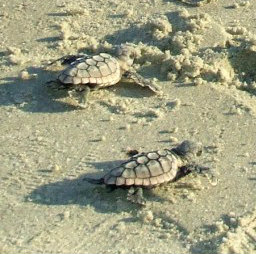
Turtle Watch Program – 2025
Members of the patrol started riding the beach every morning on May 1 and will do so through October looking for signs of turtle nests.
For more information » click here.
..
.
Turtle Talks
The Holden Beach Turtle Watch Program conducts weekly educational programs on selected Wednesday evenings in June, July and August. Please check our Events Calendar for details on dates, times and locations. Seating is limited.
Children’s Turtle Time
Special programs for younger turtle enthusiasts are held at 4 p.m. on Wednesday afternoons in June, July and August on select dates.
Both programs are free of charge and will be held at the Holden Beach Chapel.

Fauna & Flora –

NC State Native Plant Resources » click here
NC Sea Grant Coastal Landscapes » click here
New Hanover County Arboretum Native Plant Garden » click here
Audubon Native Plant Database » click here
Fauna & Flora » click here
Holden Beach recommended plant list – deer resistant & salt tolerant
Factoid That May Interest Only Me –
 There are 6 venomous snakes in North Carolina. Know what they look like.
There are 6 venomous snakes in North Carolina. Know what they look like.
There are 6 venomous snakes in North Carolina. Know what they look like.
If it’s spring, it’s time for us to remind you about some of the slithering neighbors you might encounter when you’re outdoors over the next several months. As the weather warms up in North Carolina, snakes start moving around, doing snakey things, and we are more likely to cross paths with them. They generally aren’t cause for much concern, but encounters can be a little scary for some (for the snakes as well as the people). It’s important to know that of the 38 species of snakes in North Carolina, the majority are nonvenomous and not aggressive toward people unless threatened. Arm yourself with knowledge. Learn about the venomous (sometimes incorrectly referred to as poisonous) snakes in our area, and how to distinguish them from the harmless ones.
Storm Events –
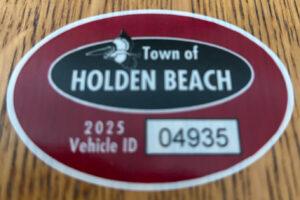 Hurricane Vehicle Decals
Hurricane Vehicle Decals
Property owners were provided with four (4) decals that were included in this month’s water bill. It is important that you place your decals in your vehicle or in a safe place. A $10 fee will be assessed to anyone who needs to obtain either additional or replacement decals. Decals will not be issued in the 24-hour period before an anticipated order of evacuation.
The decals are your passes to get back onto the island to check your property in the event that an emergency would necessitate restricting access to the island. Decals must be displayed in the driver side lower left-hand corner of the windshield, where they are not obstructed by any other items. Officials must be able to clearly read the decal from outside the vehicle.
Property owners without a valid decal will not be allowed on the island during restricted access. No other method of identification is accepted in an emergency situation. Click here to visit the Town website to find out more information regarding decals and emergency situations.
EVACUATION, CURFEW & DECALS
What is a State of Emergency?
A proclamation by the Town which enacts special ordinances and/or prohibitions during emergency situations to protect the public, public health and property. These prohibitions can include limitations on movement, curfews, directing of evacuations, controlling ingress and egress to the emergency area, alcoholic beverages, and more. State of Emergencies are issued in accordance with N.C.G.S. 166A-19.22.
What is a curfew?
A curfew is an order, typically during a State of Emergency, which requires all persons in the affected areas to remain on their own property. During a curfew, you are not free to move about public domain areas or on others’ property. Violations of a curfew could lead to arrest in certain situations.
What is a voluntary evacuation?
A voluntary evacuation creates a recommendation for all parties in the affected area to get their affairs in order hastily and evacuated.
What is a mandatory evacuation?
A mandatory evacuation means you must leave the area in which an order has been issued. With recent changes to the laws in North Carolina, you no longer have the option of staying in an area under an order of mandatory evacuation.
Why is the sewer system turned off during a storm/event?
Often the sewer system is turned off during storms which have the potential to create significant flooding on the island. The system is turned off to protect its integrity. If it were left on, it could pose a significant threat to the public health. When the system is manually shut down, it also greatly reduces the time needed to bring it back up after an event which equates to getting residents and guests back on the Island much faster.
Why is there a delay for decal holders to get back on the island once a storm ends?
After a storm, many things must occur before even limited access can be allowed. Some of those things include making sure the streets are passable; the sewer system must be restarted to comply with State laws; the utilities (water, sewer, electricity, propane supplies) must be checked to ensure no safety risk are present; and the post-storm damage assessment team needs to perform an initial assessment.
Where can I get up-to-date information during and after a storm or State of Emergency?
You can sign up for the Town email service by clicking here. The newsletter, along with the Town’s website will be the main sources of information during an emergency situation. Links to the Town’s official Facebook and Twitter pages can be found on the website. You can also download our app for Apple and Android phones by accessing the app store on your smart phone and searching Holden Beach.
Please refrain from calling Town Hall and Police Department phone lines with general information questions. These lines need to remain open for emergencies, storm management and post-storm mitigation. All updates concerning re-entry, general access, etc. may be found on the Town’s website and other media outlets.
Why do I see others moving about the island during a curfew?
If a curfew order is in place, you must stay on your own property. You may see many other vehicles moving about the Island. We often receive assistance from other local, state, federal and contract personnel during events. It is likely these are the personnel you are seeing, and they are involved in the mitigation process for the event. Please do not assume that a curfew order has been lifted and/or you are free to move about the island.
Can I check my friends’ property for them?
If a curfew order is in place, you may ONLY travel to your personally owned property. Traveling about the Island to check on others’ property is not allowed. is in place, you may ONLY travel to your personally owned property. Traveling about
Who can obtain decals?
Only property owners and businesses who service the island can obtain a decal.
How do I get decals for my vehicle…?
If I am an owner?
Decals will be mailed out in water bills to property owners before the season starts. Those owners who need additional decals can contact Town Hall. A fee may apply, please check the current fee schedule.
If I am a renter?
You must contact the owner of the property to obtain a decal.
If I am a business owner on the Island?
You must contact Town Hall to obtain a decal.
If I am a business owner off the Island that provides services on the Island?
You must contact Town Hall for eligibility and to obtain a decal.
When does my decal expire?
All decals expire on the last day of the calendar year as indicated on the decal.
Where do I put my decal on my car?
Decals must be displayed in the lower left-hand corner of the windshield, where they are not obstructed by any other items to include window tinting, other decals, etc. Officials must be able to clearly read the decal from outside the vehicle. Please note that re-entry will not be allowed if a current, intact decal is not affixed to the windshield as designated.
How do I replace a decal if I get a new vehicle?
If you trade a vehicle or otherwise need a replacement decal, you may obtain them from Town Hall during normal business hours. A fee may apply, check the current fee schedule.
Can I obtain a decal right before an emergency occurs?
While most of the storms we deal with are tropical in nature with some type of advanced warning, we do experience many other types of events that could create a State of Emergency without warning. All eligible parties should obtain decals as early as possible each year to avoid being denied access to the Island. Decals shall not be issued during the 24-hour period prior to an anticipated order of evacuation so staff can concentrate on properly preparing the Town for the storm/event.
Can I use a tax bill or another document for re-entry?
No. You MUST have a decal to re-enter the Island until it is open to the general public.
How does re-entry after a storm during a State of Emergency work?
The bridge is closed to all vehicle access, except for official vehicles. Once those with proper decals are allowed access, they must conform with the current rules in place by the specific State of Emergency Order. After all hazards have been rendered safe, the bridge will be opened to the general public. A curfew could remain in effect however, to ensure the safety and security of the Island and its residents and guests. Please understand this process typically takes days to evolve and could be significantly longer, depending on the amount of damage sustained. Please refrain from calling for times for re-entry, as those are often not set on schedule. Instead, stay tunes to local media outlets and official social media accounts for accurate updates.
How can I check on my property if access is limited to the Island?
Once it is safe, property owners with valid decals will be allowed back on the Island after a storm/event. At this point, you can travel to your property, in accordance with the rules of the specific State of Emergency Order currently in place.
If you live out of the area, please do not travel to the Island until you are certain you will be allowed access. Stay tuned to those media outlets and email services that are of official nature for this information. Also, be certain you have your current, valid decal properly affixed to your vehicle.
It is a good idea to be sure your contact information is current with the Town tax office as this is the location Town officials will use in the event you need to be contacted.
For more information » click here
NC General Statute 166A-19.22
Power of municipalities and counties to enact ordinances to deal with states of emergency.
Synopsis – The governing body may impose by declaration or enacted ordinance, prohibitions, and restrictions during a state of emergency. This includes the prohibition and restriction of movements of people in public places, including imposing a curfew; directing or compelling the voluntary or mandatory evacuation of all or part of the population, controlling ingress and egress of an emergency area, and providing for the closure of streets, roads, highways, bridges, public vehicular areas. All prohibitions and restrictions imposed by declaration or ordinance shall take effect immediately upon publication of the declaration unless the declaration sets a later time. The prohibitions and restrictions shall expire when they are terminated by the official or entity that imposed them, or when the state of emergency terminates.
Violation – Any person who violates any provisions of an ordinance or a declaration enacted or declared pursuant to this section shall be guilty of a Class 2 misdemeanor.
Hot Button Issues –
Subjects that are important to people and about which they have strong opinions

Climate
For more information » click here.
There’s something happening here
What it is ain’t exactly clear
Hottest decade
The latest “State of the Global Climate” report has been released and the news is pretty dire: our world has just experienced its hottest decade. According to the World Meteorological Organization, 2024 was the hottest since record-keeping began and was likely the first time global temperatures exceeded 1.5 degrees Celsius above the baseline set in 1850-1900. Atmospheric concentrations of carbon dioxide, methane and nitrous oxide were at the highest levels in the last 800,000 years. Such record levels of greenhouse gases — along with the El Niño weather pattern — were mostly to blame for the higher temperatures.
Earth’s 10 Hottest Years Have Been the Last 10
A report from the World Meteorological Organization confirms that 2024 was the hottest year on record and the first year to be more than 1.5 degrees Celsius above the preindustrial era.
With the addition of 2024, yet another record-hot year, the past 10 years have been the 10 hottest in nearly 200 years of record-keeping, the World Meteorological Organization reports. “That’s never happened before,” said Chris Hewitt, the director of the W.M.O.’s climate services division. It marks the first time since record keeping began that all of the 10 hottest years have fallen within the most recent decade. 2024 was the single warmest year on record, surpassing even 2023’s wide lead over other recent years. The planet’s surface was approximately 1.55 degrees Celsius warmer than its average during a reference period that approximates the preindustrial era, from 1850-1900. The annual report from the W.M.O., a United Nations agency, includes input from dozens of experts and institutions from around the world and sheds further light on the record-breaking heat of 2024 and places it in the context of Earth’s long-term warming from climate change. The extra energy in the atmosphere and the oceans helped fuel climate-related disasters around the globe. Extreme weather events like drought, storms and wildfires displaced hundreds of thousands of people from their homes, the report says. Atmospheric levels of greenhouse gases released from fossil fuel combustion continue to rise. In 2024, the concentration of carbon dioxide hit amounts unseen in at least two million years, according to the report. Concentrations of two other important greenhouse gases, methane and nitrous oxide, reached levels unseen in at least 800,000 years. Homo sapiens, or modern humans, emerged around 300,000 years ago, so our species has never before experienced an atmosphere so laden with planet-warming greenhouse gases. When countries signed the Paris Agreement in 2015, they agreed to try to limit global warming to 1.5 degrees Celsius above preindustrial levels. “While a single year above 1.5 degrees C of warming does not indicate that the long-term temperature goals of the Paris Agreement are out of reach, it is a wake-up call that we are increasing the risks to our lives, economies and to the planet,” Celeste Saulo, the secretary general of the W.M.O., said in a statement. The new report estimates that long-term warming has reached 1.25 to 1.41 degrees Celsius above preindustrial levels, although the margins of error for some estimates extend beyond 1.5 degrees. The report authors estimate that last year, El Niño and other factors contributed an additional 0.1 or 0.2 of a degree of temporary warming. El Niño is a natural climate pattern that tends to slightly raise the overall surface temperature of the planet. Record warmth, however, continued into 2025, even through El Niño’s transition into the opposing pattern, La Niña. “It’s been really quite extraordinary to see that warmth continue for so long,” John Kennedy, the scientific coordinator and lead author of the report, said during a call with reporters. This warmth is especially apparent in the oceans, where key indicators of climate change are now accelerating. The oceans have so far absorbed around 90 percent of the additional heat trapped inside Earth’s atmosphere by greenhouse gases. The oceans’ heat content — a way to measure this warmth throughout different depths — also reached a record high last year. Over the past two decades, from 2005 to 2024, the oceans warmed more than twice as fast as they did from 1960 to 2005, according to the report. Increased ocean temperatures have had devastating consequences for marine life. By April 2024, warm-water corals had been bleached in every ocean basin where they grow. Global average sea-level rise also reached a record high in 2024, according to the report. The speed at which the seas are rising has also more than doubled in recent years: 4.7 millimeters per year in the past decade, from 2015 to 2024, compared with 2.1 millimeters per year from 1993 to 2002. The World Meteorological Organization’s work depends on international cooperation among its 101 member countries, including the United States. “If you look at how weather has progressed since the initiation of the W.M.O. in 1950, you can now see that you can have the forecast on your smartphone,” said Omar Baddour, the W.M.O.’s chief of climate monitoring. “You cannot believe how much collaboration is behind this.” Data from NASA and the National Oceanic and Atmospheric Administration, which recently lost hundreds of staff positions as part of the rapid, large-scale cuts to the federal bureaucracy the Trump administration undertook beginning earlier this year, are included in the W.M.O.’s new report.
Read more » click here

Flood Insurance Program
For more information » click here
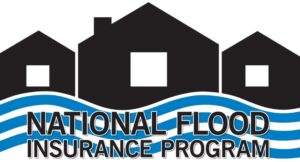
National Flood Insurance Program: Reauthorization
Congress must periodically renew the NFIP’s statutory authority to operate. On March 14, 2025, the president signed legislation passed by Congress that extends the National Flood Insurance Program’s (NFIP’s) authorization to September 30, 2025.
Congress must now reauthorize the NFIP
by no later than 11:59 pm on September 30, 2025.

GenX
For more information » click here

Homeowners Insurance
For more information » click here
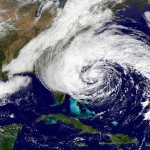
Hurricane Season
For more information » click here
Hurricane season runs from June 1 through November 30
What early signs suggest about the 2025 hurricane season ahead
A marine heat wave in the Caribbean Sea may fuel an impactful hurricane season in 2025, even though seas have cooled in some areas compared to last year.
Hurricane season is just two months away, and early indications suggest it might not be as hyperactive as last year’s. Still, several factors hint that it won’t be quiet, either. For one, forecasters are looking to the oceans for signs of what could be brewing. Seas in the part of the Atlantic where storms typically form are cooler than they were at this time in 2024 — with warmer waters allowing more fuel for strengthening. But seas are nonetheless about 0.7 degrees higher than the long-term average, the eighth-warmest on record since at least 1940. A marine heat wave remains active across the Caribbean Sea and parts of the Gulf of Mexico — blobs of unusual ocean heat that, should they linger, may tip the scales toward stronger storms close to land. However, La Niña, which tends to boost hurricane activity, is fading. Still, no matter how many (or how few) storms form, it takes only one landfall to make a hurricane season devastating. Last year, five hurricanes made landfall in the contiguous United States — just the ninth season since 1851 to have at least five storm centers hit land. There were 18 storms in total, and the season was considered hyperactive, according to a metric called accumulated cyclone energy. Ahead of further key forecasts, including one from Colorado State University expected later this week, here’s The Washington Post’s assessment for the coming season, and the four key factors that will shape it:
Key factors this hurricane season
Sea temperatures in the Main Development Region
From August to October, tropical storm and hurricane seedlings move from Africa into a vast region of warm seas in the tropical Atlantic Ocean known as the Main Development Region (MDR). The warmer it is, the more energy and moisture are available to fuel storms, allowing them to strengthen as they move through the area. Last year, the MDR was record warm, which is part of the reason forecasters expected such an active season. The MDR is cooler than it was at this time in 2024, especially near the coast of Africa, but it’s still unusually warm overall. In March, it’s been the eighth-warmest on record. Miami-based hurricane expert Michael Lowry is closely watching sea temperatures in this important region. “I certainly see some encouraging trends which suggest this upcoming season could be less active overall than recent hyperactive ones. The Atlantic remains plenty warm — much warmer than average — but after almost two years of unprecedented warmth, it’s nice to see water temperatures fall to more precedented levels,” said Lowry, a hurricane specialist with Local 10 News in Miami.
Sea temperatures in the tropical Pacific Ocean
The global climate patterns El Niño and La Niña play a critical role in determining how busy hurricane season may be. La Niña, which tends to boost hurricane activity by creating winds more conducive to their formation, has waned in recent months. The tropical Pacific Ocean is now a mix of warmer and cooler-than-average waters — moving toward what is known as a neutral phase. In other words, having neither La Niña nor El Niño. Odds are that neutral conditions will be in place for the start of hurricane season, but this time of year presents challenges for forecasting because of a phenomenon known as the spring predictability barrier. “So-called neutral years can also be quite active in the Atlantic, so unless we see a big warm-up toward El Niño over the next four or five months, the Pacific shouldn’t be a major deterrent this season,” Lowry said.
A marine heat wave in the Caribbean Sea
Ocean water across the Caribbean Sea and western Gulf of Mexico is well above average for the time of year — enough to qualify as a marine heat wave. These vast expanses of unusual ocean heat can affect coral reefs and the behavior of marine life but also provide more moisture and fuel for tropical weather systems. Last year, Hurricanes Helene and Milton derived their energy from a gulf affected by a marine heat wave. Both storms broke atmospheric moisture records, which contributed to extreme rainfall.
The West African monsoon
During June to September, heavy rains and thunderstorms bubble up over the West African Sahel. The strongest disturbances survive the long journey across Africa and emerge in the Atlantic — where they meet increasingly warm seas and strengthen further into tropical storms and hurricanes. How active the African monsoon season is helps determine how many storms may move into the Atlantic. The early indication is there will be a more active monsoon than normal. But not all monsoons are equal — last year’s episode sent storms swirling unusually far north into the Sahara, where it rains very little. Such oddities are not predictable months in advance. Other factors, such as dust from the Sahara, can reduce hurricane risk as the dry air suppresses rainfall and thunderstorm activity across the Atlantic — and can cool the ocean. But it’s not typically possible to predict dust outbreaks more than a week or so in advance. Last season, Hurricane Ernesto ingested wildfire smoke as it moved past Newfoundland, Canada. The intersection of hurricanes and wildfires will be something to watch this season, particularly as many parts of the United States continue to deal with drought impacts.
What is known — and what remains uncertain
It’s not possible to predict exactly when or where a tropical storm or hurricane will strike weeks or months in advance. But a broad-brush understanding of the theme of hurricane season can be developed by comparing current conditions to the past and forecast models. Forecasters analyze several key metrics and use a variety of techniques to help understand whether the season might be quiet or busy, relative to an average season, which has 14 named storms, seven hurricanes and three major hurricanes (Category 3 or higher). The key predictors currently suggest that a slightly above average Atlantic hurricane season in 2025 is possible, but the hyperactive characteristics present in 2024 are fading. Lowry called hurricane season “a marathon, not a sprint” — and referred to the 1992 season, when Andrew, a hurricane with deadly impacts in South Florida, was the first and only major Atlantic hurricane of the year. He urged early preparations for any scenario. “Emergency managers and disaster planners don’t alter their plans based on the seasonal outlooks, and neither should you or your family,” Lowry said. “Prepare this year as you would any other year. It only takes one bad hurricane to make it a bad season where you live.”
Read more » click here
As the NC coast gears up for hurricane season, a big change is coming to forecast maps
We’re still a couple of months out from the start of the 2025 Atlantic hurricane season, which is the perfect time to start preparing. Gearing up for hurricane season entails more than just making sure your hurricane supplies are topped off. Making sure you can receive the latest weather updates and staying on top of what’s new for the 2025 hurricane season is just as important. The National Hurricane Center has already announced more than a few changes it’s making for the upcoming hurricane season, like updating its “cone of uncertainty” and providing an earlier window to send alerts about potential tropical activity.
Here’s what to know about what’s news for the 2025 Atlantic hurricane season.
The NHC is updating its Potential Tropical Cyclone system for 2025
Starting on May 15, the National Weather Service (NWS) will implement some significant changes to its Potential Tropical Cyclone advisory (PTC) system.
- Extended forecast window: The National Hurricane Center will be able to issue PTC advisories up to 72 hours before anticipated impacts, which is up from the previous 48-hour window.
- Relaxed warning criteria: The change eliminates the previous requirement that advisories could only be issued for PTCs that required land-based watches or warnings.
The experimental cone of uncertainty will be narrower
The NHC says it will continue using its experimental cone graphic, which is frequently referred to as the cone of uncertainty. The graphic is meant to track the probable path of a tropical cyclone’s center. The cone is frequently misunderstood, which is one reason the NHC consistently updates the product. Here are this year’s changes.
- New symbols: The cone of uncertainty legend will now contain symbology for areas where a hurricane watch and tropical storm are in effect at the same time, marked by diagonal pink and blue lines.
- Narrower cone of uncertainty: The size of the tropical cyclone track forecast error cone will be about 3-5% smaller compared to last year.
New rip current risk map will highlight dangerous conditions stemming from hurricanes
Due to an increase in surf and rip current fatalities in the United States, the NHC will provide current risk information from distant hurricanes and provide a national rip current risk map.
- Rip current risk map: To highlight the risk of dangerous conditions, NHC will provide rip current risk information from local National Weather Service and Weather Force Cast Offices in the form of a map.
Current day, next day and a composite showing the highest risk over both days will be available for areas along the East and Gulf coasts of the U.S in one page.
Read more » click here
Hurricane season is 3 months away. Will it be as active as last year?
What to know at this early stage.
One of the first things that tipped scientists off that 2024 would be an unusually active hurricane season: excessive ocean warmth in a key region of the Atlantic Ocean. But that’s just one of many factors different as this year begins. With the Atlantic hurricane season less than three months away, forecasters are making early efforts to understand how this year may differ from the last. And while specific forecasts for the number of hurricanes can’t be accurately made this far out, forecasters can look to planetary climate patterns for clues. At least two key differences suggest odds are lower for another extremely active season: For one, the tropical Atlantic isn’t as warm as it was last year. And a La Niña (known for cooling a vast swath of the Pacific Ocean) is not expected to form during the season. But it’s still early — and current conditions don’t entirely eliminate the odds of an overactive season. In the Atlantic Ocean, hurricane season runs from June through November, typically peaking in September. Last year, hurricane season was hyperactive, based on a metric called Accumulated Cyclone Energy. There were 18 named storms and five hurricane landfalls in the United States, including the devastating Hurricane Helene.
The Atlantic is cooler than last year
Among the many complex puzzle pieces that start to create a picture of hurricane season — including winds, air pressure patterns, Saharan Dust and monsoonal activity — sea temperatures are a key driver. Scientists look as an early signal to what’s called the Atlantic Main Development Region, or MDR, which extends from the Caribbean to the west, and to near Africa in the east. Sea surface temperatures in the MDR have a statistical relationship with hurricane activity. In 2024, there was excessive warmth in the MDR. But it’s not currently as warm as last year, nor is it forecast to be in a few months. When the MDR is cooler, it can contribute to atmospheric conditions that aren’t particularly conducive to lots of hurricanes. Forecasts for the MDR extend to July 2025, and they suggest that while seas in the region may be somewhat above-average, the Atlantic’s most unusual warmth will be located farther north. Comparing forecasts made for July of both years shows how much warmer the MDR was predicted to be in 2024 — a prediction that turned out to be correct. If the predictions hold true this year, that might reduce the odds for a season as active as 2024. Andy Hazelton, a physical scientist with the National Oceanic and Atmospheric Administration’s Environmental Modeling Center, said the cooling of the MDR is the biggest factor that has stood out to him so far. “It’s still pretty warm, especially in the Caribbean, but the subtropics (north of the MDR) look warmer overall right now,” Hazelton said. If the pattern were to continue, he said, it could put a cap on how active the season may be.
La Niña may be fading
During hurricane season, the Pacific and Atlantic oceans are more than distant neighbors — they’re connected by the atmosphere. What happens in one doesn’t stay there; it sends ripples to the other, shaping storm activity on both sides. One pattern that causes a Pacific-Atlantic ripple effect is known as the El Niño-Southern Oscillation (ENSO), which has three phases: El Niño, La Niña and neutral. El Niño is marked by warmer-than-average seas in the eastern Pacific, while cool seas are prominent there during La Niña. Neutral periods often occur during transitions between El Niño and La Niña, as sea temperatures temporarily become less anomalous. Early this year, the tropical Pacific entered a La Niña phase — but it’s not expected to last for much longer. The cool waters associated with La Niña can suppress rainfall and thunderstorm activity in the tropical Pacific. But as the atmosphere balances itself, increased rainfall and thunderstorm activity, as well as winds that are more conducive to hurricane formation, can occur in the tropical Atlantic. This is why, in addition to the record-warm Atlantic seas, forecasters were so concerned about the level of hurricane activity last year. But a period of weaker winds in the eastern Pacific this month has caused a substantial warming of the ocean to the west of South America. Because the winds have been less robust, a process known as upwelling — which happens when strong winds churn cool, subsurface waters to the surface — has slowed down. If the warming continues, it will put the Pacific in a much different state than it was heading into the last hurricane season. This year, a developing tongue of warm water in the eastern Pacific could have the opposite effect as it did last year, promoting rising air and more rainfall there, while having a drying effect on the Atlantic. However, predictions of El Niño and La Niña are not made equal. A phenomenon known as the “spring predictability barrier” can lead to less-skillful forecasts during spring in the Northern Hemisphere. “ENSO still has the spring barrier to cross,” Hazelton said. “But cool subsurface conditions and persistent trade winds suggest we probably won’t be getting a rapid flip or setting up for El Niño in the summer.”
The bottom line: It’s still early, but 2025 looks different
One thing can be said confidently at this point: So far this year, the elements that drive the Atlantic hurricane season look markedly different from 2024. The Atlantic Ocean is shaping up to have a different sea-temperature configuration than last year, with the most unusually warm seas sitting outside of the MDR. A marine heat wave — expansive blobs of unusual oceanic heat that are becoming more common in a warming climate — no longer covers the MDR, but remains active in the Caribbean and Gulf of Mexico, areas where hurricanes derive their energy from. In the Pacific, the door may be closing on La Niña as seas warm up in the east. But a full-fledged, hurricane-halting El Niño doesn’t look particularly likely, either. Hazelton said it’s possible there will be ENSO neutral conditions during peak hurricane season. These are some of the factors forecasters will be monitoring closely as hurricane season approaches. Seasonal outlooks of hurricane activity are typically released in April and May. And while the data may change, one thing is certain: It’s never too early to prepare, especially considering the United States experienced impactful landfalls from Hurricanes Beryl, Debby, Francine, Helene and Milton last year.
Read more » click here
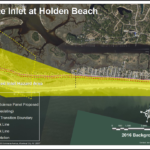
Inlet Hazard Areas
For more information » click here
.
Lockwood Folly Inlet
For more information » click here.

Seismic Testing / Offshore Drilling
For more information » click here.

Offshore Wind Farms
For more information » click here
Things I Think I Think –
 Eating out is one of the great little joys of life.
Eating out is one of the great little joys of life.
Restaurant Review:
The Dinner Club visits a new restaurant once a month. Ratings reflect the reviewer’s reaction to food, ambience and service, with price taken into consideration.
///// December 2023
Name: Villa Romana
Cuisine: Italian
Location: 707 South Kings Highway, Myrtle Beach SC
Contact: 843.448.4990 / https://www.villaromanamyrtlebeach.com/
Food: Average / Very Good / Excellent / Exceptional
Service: Efficient / Proficient / Professional / Expert
Ambience: Drab / Plain / Distinct / Elegant
Cost: $23 Inexpensive <=20 / Moderate <=26 / Expensive <=35 / Exorbitant <=60
Rating: Three Stars
A quintessential Italian restaurant, it feels like the great Italian restaurants that were more prevalent many years ago. Apparently, they have renovated since our last visit the traditional Roman architecture with its columns, statues, and fountains have been removed. Frankly, although it was a bit kitschy I miss them. The roving accordion player contributes to its old-world charm. Established in 1985, the menu reflects home-style interpretations of their family recipes that have been handed down from generation to generation. What makes them great is they are happy to prepare any dishes you want as long as the ingredients are available. It’s an exceptional value, the food is wonderful, the portions are generous, and the prices are reasonable. What’s not to like?
Family-run Italian restaurant celebrates four decades in Myrtle Beach
Bringing authentic Italian cuisine to the Grand Strand since 1985, Villa Romana is celebrating 40 years of business. The restaurant is a family business, owned by husband and wife, Franand Rinaldo Montrosse. It’s located in downtown Myrtle Beach, but when you walk through the doors, it’s as if you are in Rome, where Rinaldo is from. And it’s his mother’s style of cooking that lives on through the entrees. Now, reaching four decades of serving the community, the head chef and general manager Vince Pappas said they owe it all to the local clientele. “We depend greatly upon the locals, and so we try to give back to that community every day,” he said. “They take very good care of us without our locals we would not be here.”
Read more » click here
Dining Guide – Local * Lou’s Views
Dining Guide – North * Lou’s Views
Dining Guide – South * Lou’s Views
Restaurant Reviews – North * Lou’s Views
Restaurant Reviews – South * Lou’s Views
Book Review:
Read several books from The New York Times best sellers fiction list monthly
Selection represents this month’s pick of the litter

.
PRESUMED GUILTY by Scott Turow
This is the third entry in the series of legal thriller novels featuring the former prosecutor and now retired judge Rusty Sabich. Rusty is back in the courtroom, defending the son of his fiancée who is accused of murdering the daughter of the local prosecutor.
That’s it for this newsletter
See you next month
Lou’s Views . HBPOIN
. • Gather and disseminate information
. • Identify the issues and determine how they affect you
. • Act as a watchdog
. • Grass roots monthly newsletter since 2008

